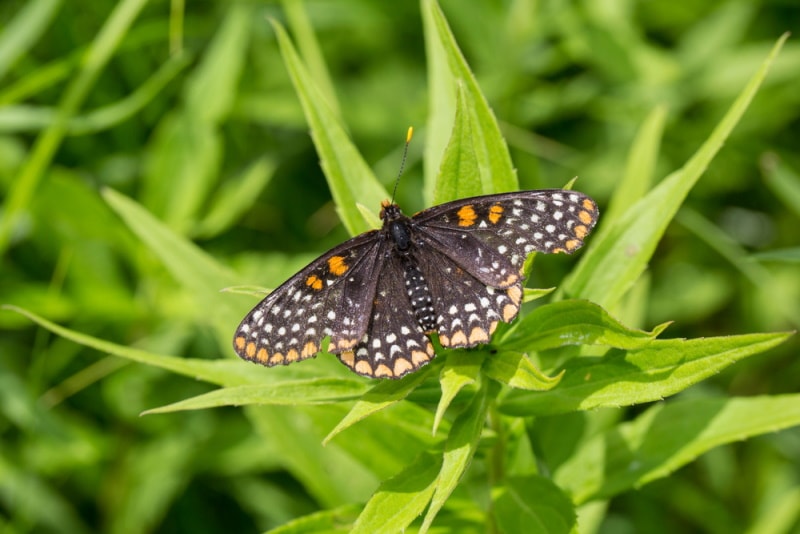What Is the State Insect of Maryland? Symbolism & History
-
Pete Ortiz
- Last updated:

Did you know that every state in the United States, excluding Iowa and Michigan, has an official state insect? The state insect of Maryland has been the Baltimore Checkerspot butterfly (Euphydryas phaeton)1 since it was made official in 1973.
Although the specific law that allocated it as the state insect never gave the reason for its designation, the butterfly’s name has come to endear it to all Marylanders with its gold and black repeating George Calvert’s family (the 1st Lord Baltimore).
In this article, we look at how Maryland’s state insect came to be as well as its significance to the environment.
Symbolism of State Insects
A state insect is chosen by a government as a symbol or emblem of that state. Of the 50 US states, only 48 have designated state insects,2 and this excludes Iowa and Michigan, as already mentioned. On the other hand, some states have more than one state insect with different categories, official state butterfly and official state insect.
State insects are often chosen to promote naturalism, represent the agricultural industry, or symbolize the state’s history. However, not all state-designated insects are native to North America. In fact, less than half are native to North America due to the selection of three native European species (the European mantis,3 the 7-spotted ladybird,4 and the European honey bee).5
How Was the Baltimore Checkerspot Butterfly Chosen as Maryland’s State Insect?
The Baltimore Checkerspot was nominated by a group of schoolchildren from Baltimore County as part of a statewide contest to choose the state insect. Their teacher, Mrs. Smith, had her class research different insects before they made their nomination.
The adoption of the Baltimore Checkerspot as Baltimore state insect was partly because of its black and bright orange colors, representing the colors of Maryland’s founders, the Calvert family.

Characteristics of the Baltimore Checkerspot Butterfly
The Baltimore Checkerspot species is native to the eastern United States and Canada. Johan Christian Fabricius first described it in 1793. He named it after Baltimore city in Maryland, where its numbers were prominent. Like bees, the Baltimore Checkerspot is a pollinator for wild flora and farm crops.
The butterfly has a wingspan of 1.5 to 2 inches (3.8 to 5.1 cm) and is black with orange spots on its wings. It is considered one of the most beautiful butterflies in North America. Its thorax and body have a dark brown color that extends to its wings, which are spotted white in the middle section and orange on the edges.
It also has prominent antennae knobs, a trait of the family Nymphalidae. As a member of the family Nymphalidae (Brush-footed butterflies), the Baltimore Checkerspot also bears hairy forelegs, which are too short for walking.
Benefits of the Baltimore Checkerspot to the Ecosystem
As stated above, the Baltimore Checkerspot is an essential pollinator for wildflowers and crops. As the butterfly flits from flower to flower, it collects pollen on its body and transfers it to the next flower, fertilizing it in the process. This pollination helps to ensure the continued reproduction of plants.
The Baltimore Checkerspot is also an essential part of the food chain. Larvae and adults are food for predators such as birds, mice, lizards, and spiders. These predators, in turn, provide food for other animals further up the food chain.

Is Baltimore Checkerspot Endangered?
The Baltimore Checkerspot is listed as a species of special concern by the Maryland Department of Natural Resources, meaning it is not currently endangered but has a declining population. The state has put in place conservation measures to preserve and restore the butterfly’s habitat.
There are several threats to these butterflies, which include habitat loss, pesticides, and climate change.
- Habitat loss is a significant threat to the Baltimore Checkerspot. The butterfly’s natural habitats, including fields, marshes, and woodlands, are being lost to development, thus largely contributing to the decline in the Baltimore Checkerspot population.
- The use of pesticides can kill butterfly larvae, which ultimately leads to a decline in the population.
- Climate change, including rising temperatures and changes in precipitation patterns, can lead to the loss of the butterfly’s habitat and make it easier for predators to find and eat their larvae.
The decline of the Baltimore Checkerspot has been a cause for concern among environmentalists and butterfly lovers. However, thanks to conservation efforts, the Baltimore Checkerspot population is slowly but surely beginning to rebound.

What Is the Host Plant for Baltimore Checkerspot?
The Baltimore Checkerspot’s host plant is the White Turtlehead (Chelone glabra). Like other butterflies, it searches for a host plant on which it lays its eggs. After the eggs hatch, the host plant provides food for the larvae until they become adults.
The orange and black larvae feed on the Turtlehead flowers and leaves, while the adults drink nectar from the flowers. The White Turtlehead is an important food source for the Baltimore Checkerspot and other butterflies, as it is one of the few plants that bloom late in the season.
What Other States Have a State Butterfly?
Besides state insects, some states also have a state butterfly. The Baltimore Checkerspot is the state butterfly of Maryland. Other US states with state butterflies include Arizona, Arkansas, California, Delaware, Florida, Georgia, Kentucky, Minnesota, Mississippi, Montana, New Hampshire, New Jersey, New Mexico, North Carolina, Oklahoma, South Carolina, Tennessee, Vermont, and West Virginia.
State butterflies are chosen through a process that involves nominations from the public. A committee then reviews the nominations and makes a recommendation to the state legislature. The state legislature then votes on the proposal, and if it is approved, the state officially adopts the butterfly as its state insect.

Conclusion
Chosen in 1973 by a group of school children, the Baltimore Checkerspot is the state butterfly of Maryland. It is a beautiful butterfly that was once common in the eastern United States, but its population has declined due to habitat loss and other threats.
However, thanks to conservation efforts, the Baltimore Checkerspot population is slowly but surely beginning to rebound.
Related Reads:
Featured Image Credit: Kevin Collison, Shutterstock
Contents



